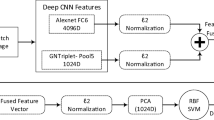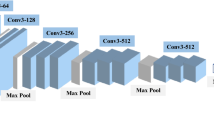Abstract
Sketch-to-photo recognition is an important challenge in face recognition because it requires matching face images in different domains. Even the deep learning, which has recently been deployed in face recognition, is not efficient for face sketch recognition due to the limited sketch datasets. In this paper, we propose a novel face sketch recognition approach based on transfer learning. We design a three-channel convolutional neural network architecture in which the triplet loss is adopted in order to learn discriminative features and reduce intra-class variations. Moreover, we propose a hard triplet sample selection strategy to augment the number of training samples and avoid slow convergence. With the proposed method, facial features from digital photos and from sketches taken from the same person are closer; the opposite occurs if the digital photo and sketch are from different identities. Experimental results on multiple public datasets indicate that the proposed face sketch recognition method outperforms the existing approaches.











Similar content being viewed by others
References
Peng C, Wang N, Gao X, Li J (2018) Face recognition from multiple stylistic sketches: scenarios, datasets, and evaluation. Pattern Recognit 84:262–272
Wang N, Gao X, Sun J, Li J (2017) Anchored neighborhood index for face sketch synthesis. IEEE Trans Circuits Syst Video Technol 28:2154–2163
Samma H, Suandi SA, Mohamad-Saleh J (2018) Face sketch recognition using a hybrid optimization model. Neural Comput Appl. https://doi.org/10.1007/s00521-018-3475-4
Liu D, Li J, Wang N, Peng C, Gao X (2018) Composite components-based face sketch recognition. Neurocomputing 302:46–54
Zhang W, Wang X, Tang X (2011) Coupled information-theoretic encoding for face photo-sketch recognition. In: Proceedings of the IEEE conference on computer vision and pattern recognition, pp 513–520
Klare B, Li Z, Jain A (2011) Matching forensic sketches to mug shot photos. IEEE Trans Pattern Anal Mach Intell 33:639–646
Galoogahi H, Sim T (2012) Inter-modality face sketch recognition. In: Proceedings of the IEEE international conference on multimedia and expo, pp 224–229
Alex A, Asari V, Mathew A (2013) Local difference of gaussian binary pattern: robust features for face sketch recognition. In: IEEE international conference on systems, man, and cybernetics, pp 1211–1216
Klare BF, Jain AK (2013) Heterogeneous face recognition using kernel prototype similarities. IEEE Trans Pattern Anal Mach Intell 35:1410–1422
Tang X, Wang X (2003) Face sketch synthesis and recognition. In: Proceedings of the IEEE conference on computer vision, pp 687–694
Liu Q, Tang X, Jin H, Lu H, Ma S (2005) A nonlinear approach for face sketch synthesis and recognition. In: Proceedings of the IEEE conference on computer vision and pattern recognition, pp 1005–1010
Li J, Yu X, Peng C, Wang N (2017) Adaptive representation-based face sketch-photo synthesis. Neurocomputing 269:152–159
Wang N, Gao X, Li J (2018) Random sampling for fast face sketch synthesis. Pattern Recognit 76:215–227
Zhang L, Lin L, Wu X, Ding S, Zhang L (2015) End-to-end photo-sketch generation via fully convolutional representation learning. In: Proceedings of the 5th ACM on international conference on multimedia retrieval, pp 627–634
Wang N, Zha W, Li J, Gao X (2018) Back projection: an effective postprocessing method for gan-based face sketch synthesis. Pattern Recognit Lett 107:59–65
Jiao L, Zhang S, Li L, Liu F, Ma W (2018) A modified convolutional neural network for face sketch synthesis. Pattern Recognit 76:125–136
Jiang J, Yu Y, Wang Z, Liu X, Ma J (2019) Graph-regularized locality-constrained joint dictionary and residual learning for face sketch synthesis. IEEE Trans Image Process 28:628–641
Lin D, Tang X (2006) Inter-modality face recognition. In: Proceedings of the 9th European conference on computer vision, pp 13–26
Lei Z, Li S (2009) Coupled spectral regression for matching heterogeneous faces. In: Proceedings of the IEEE conference on computer vision and pattern recognition, pp 1123–1128
Lei Z, Zhou C, Yi D, Jain A, Li S (2012) An improved coupled spectral regression for heterogeneous face recognition. In: Proceedings of the international conference on biomedical, pp 7–12
Sharma A, Jacobs D (2011) Bypass synthesis: PLS for face recognition with pose, low-resolution and sketch. In: Proceedings of the IEEE conference on computer vision and pattern recognition, pp 593–600
Mignon A, Jurie F (2012) CMML: a new metric learning approach for cross modal matching. In: Proceedings of the Asian conference on computer vision, pp 1–14
Kan M, Shan S, Zhang H, Lao S, Chen X (2012) Multi-view discriminant analysis. In: Proceedings of the 12th European conference on computer vision, pp 808–821
Huo J, Gao Y, Shi Y, Wang Y, Yin H (2018) Heterogeneous face recognition by margin-based cross-modality metric learning. IEEE Trans Cybern 48:1814–1826
Schroff F, Kalenichenko D, Philbin J (2015) Facenet: a unified embedding for face recognition and clustering. In: Proceedings of the IEEE conference on computer vision and pattern recognition, pp 815–823
Parkhi OM, Andrea V, Andrew Z (2015) Deep face recognition. Br Mach Vis Conf 1:1–6
Galea C, Farrugia RA (2017) Forensic face photo-sketch recognition using a deep learning-based architecture. IEEE Signal Process Lett 24:1586–1590
Mittal P, Vatsa M, Singh R (2015) Composite sketch recognition via deep network—a transfer learning approach. In: Biometrics (ICB), 2015 IEEE international conference on, pp 251–256
Zhang H, Ji Y, Huang W, Liu L (2018) Sitcom-star-based clothing retrieval for video advertising: a deep learning framework. Neural Comput Appl. https://doi.org/10.1007/s00521-018-3579-x
Zhang H, Cao X, Ho JKL, Chow TWS (2017) Object-level video advertising: an optimization framework. IEEE Trans Ind Inf 13:520–531
Wang X, Tang X (2009) Face photo-sketch synthesis and recognition. IEEE Trans Pattern Anal Mach Intell 31:196–1955
Bhatt HS, Bharadwaj S, Singh R, Vatsa M (2011) Memetic approach for matching sketches with digital face images. Technical Report TR-2011-006, Indraprastha Institute of Information Technology, New Delhi, India
King DE (2009) Dlib-ml: a machine learning toolkit. J Mach Learn Res 10:1755–1758
Bolle RM, Connell JH, Pankanti S et al (2005) The relation between the ROC curve and the CMC. In: Fourth IEEE workshop on automatic identification advanced technologies, pp 15–20
Lenc L, Pavel K (2015) Automatic face recognition system based on the SIFT features. Comput Electr Eng 46:256–272
Ding C, Choi J, Tao D, Davis LS (2016) Multi-directional multi-level dual-cross patterns for robust face recognition. IEEE Trans Pattern Anal Mach Intell 38:518–531
Wu X, He R, Sun Z, Tan T (2018) A light CNN for deep face representation with noisy labels. IEEE Trans Inf Forens Secur 13:2884–2896
Yang S, Luo P, Loy CC, Tang X (2015) From facial parts responses to face detection: a deep learning approach. In: IEEE international conference on computer vision, pp 3676–3684
Acknowledgements
This research was supported by Basic Science Research Program through the National Research Foundation of Korea (NRF) funded by the Ministry of Education (GR 2016R1D1A3B03931911). This study was also financially supported by the grants of China Scholarship Council (CSC No. 201708260057). This work was also supported in part by the National Natural Science Foundation of China under Grants 61802253, in part by the Collaborative Innovation Center for Economic Crime Investigation and Prevention Technology of Jiangxi Province under Grant JXJZXTCX-027, in part by the Shanghai Chenguang Talented Program under Grant 17CG59.
Author information
Authors and Affiliations
Corresponding author
Ethics declarations
Conflict of interest
The authors declare no conflict of interest. We declare that we do not have any commercial or associative interest that represents a conflict of interest in connection with the work entitled “Transfer Deep Feature Learning for Face Sketch Recognition.”
Additional information
Publisher's Note
Springer Nature remains neutral with regard to jurisdictional claims in published maps and institutional affiliations.
Rights and permissions
About this article
Cite this article
Wan, W., Gao, Y. & Lee, H.J. Transfer deep feature learning for face sketch recognition. Neural Comput & Applic 31, 9175–9184 (2019). https://doi.org/10.1007/s00521-019-04242-5
Received:
Accepted:
Published:
Issue Date:
DOI: https://doi.org/10.1007/s00521-019-04242-5




